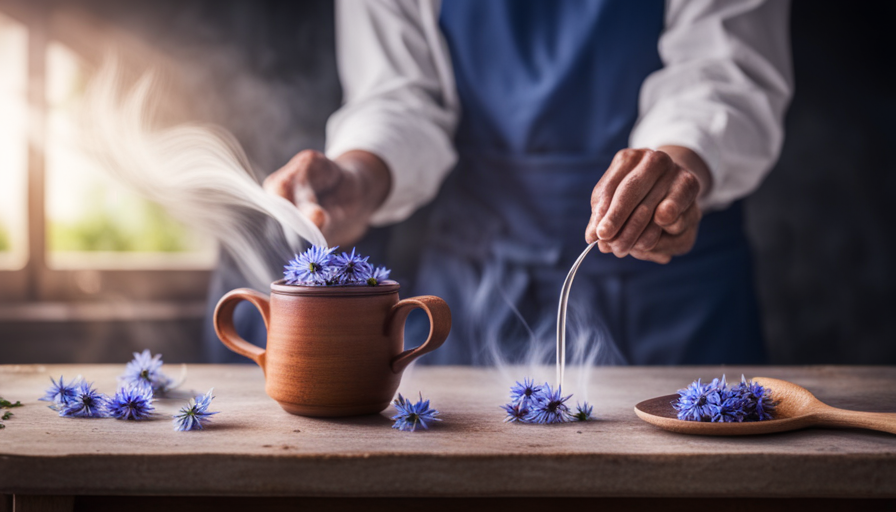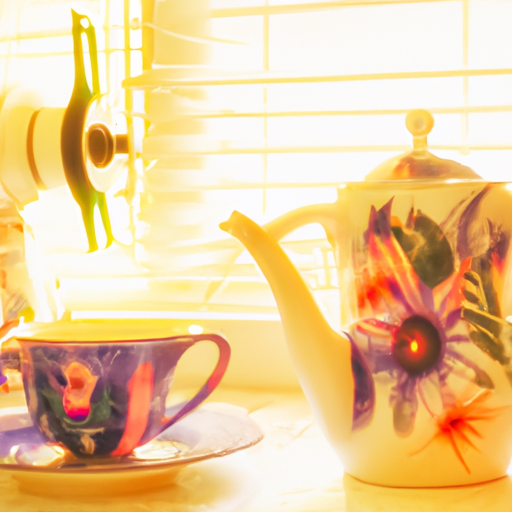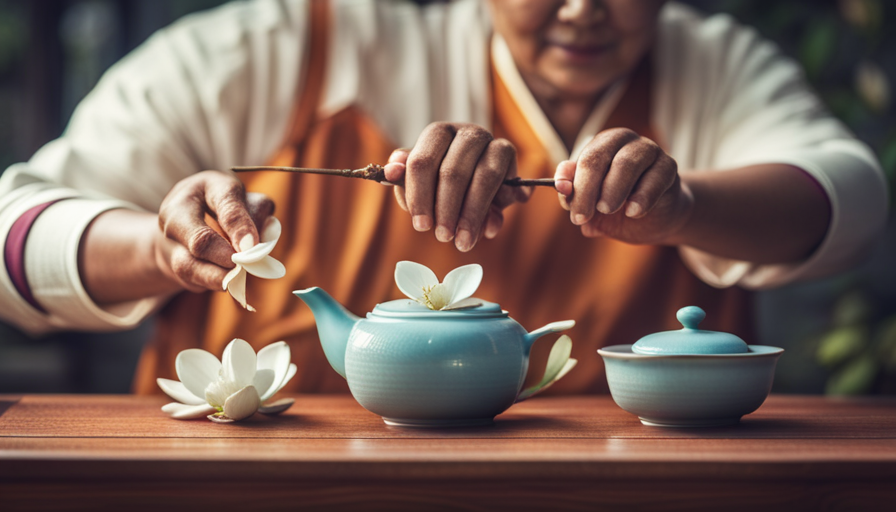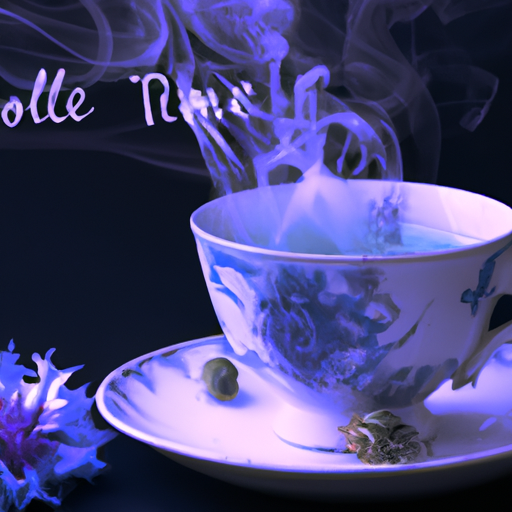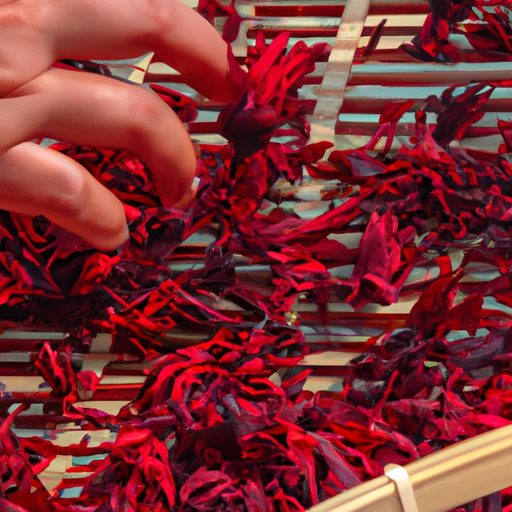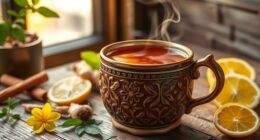Welcome to the magical realm of borage flower tea, where each sip transports you to a field of colorful blossoms and delicious tastes.
Imagine a warm embrace of delicate petals, releasing their essence as you indulge in each sip.
In this article, I will guide you through the art of making borage flower tea, a delightful beverage that not only captivates your senses but also offers numerous health benefits.
With its brilliant blue hue and refreshing taste, borage flower tea has been cherished for centuries for its soothing and rejuvenating properties.
To embark on this delightful tea-making adventure, we will gather fresh borage flowers, carefully prepare the tea ingredients, and steep them in boiling water to extract the full essence of this remarkable flower.
As the tea infuses, we can sweeten and enhance the flavor, if desired, before serving and indulging in the delightful experience of borage flower tea.
So, join me in unlocking the secrets of borage flower tea, and discover a world of beauty and wellness in each fragrant cup.
Key Takeaways
- Borage flower tea is a delightful and soothing beverage with vibrant blooms and tantalizing flavors.
- It offers numerous health benefits, including reducing inflammation, alleviating stress and anxiety, and promoting better sleep.
- Borage flowers can be gathered and prepared to extract their essence, and the tea can be sweetened and enhanced for added flavor.
- There are various flavor profiles and customization options, such as adding lemon or mint, steeping longer for a stronger flavor, and serving hot or cold depending on preference.
Introduction to Borage Flower Tea
Want to try a unique and refreshing herbal tea? Look no further than borage flower tea! Borage flower tea is not only delicious but also offers a plethora of health benefits.
This herbal infusion has been enjoyed for centuries due to its numerous medicinal properties. Borage flower tea is known for its calming effect on the mind and body. It helps alleviate stress and anxiety, making it the perfect beverage to unwind after a long day. Additionally, it has anti-inflammatory properties that can aid in reducing inflammation and easing joint pain.
The history of borage flower tea dates back to ancient times, where it was used in traditional medicine for various ailments. It was believed to have a cooling effect on the body and was used to treat fevers and respiratory issues.
To make borage flower tea, the first step is to gather fresh borage flowers. These vibrant blue flowers can be found in gardens or grown at home. Once you have collected the flowers, you can then proceed to prepare the tea.
Gather Fresh Borage Flowers
First, head outside to the garden and scout for vibrant borage blossoms. Borage flowers are easy to identify with their beautiful blue or purple petals and star-like shape. Look for flowers that are fully bloomed and free from damage or discoloration.
Once you’ve gathered a handful of fresh borage flowers, there are a few ways you can utilize them. Borage flowers can be used in various recipes to add a unique touch. They can be added to salads, used as a garnish for desserts, or even infused into syrups and cocktails. The delicate flavor of borage flowers adds a subtle cucumber-like taste to any dish.
If you have an abundance of borage flowers, you can also dry and store them for future use. To dry the flowers, simply spread them out on a clean, dry surface and leave them in a well-ventilated area for about two weeks. Once they’re completely dry, store them in an airtight container in a cool, dark place.
Now that you’ve gathered your fresh borage flowers and explored their various uses, it’s time to move on to preparing the tea ingredients.
Prepare the Tea Ingredients
To start preparing the tea, you’ll need to gather a few simple ingredients and your favorite teapot. First, you’ll need borage flowers, which you’ve already gathered in the previous step. Make sure they’re fresh and vibrant, as this’ll enhance the flavor of your tea.
Additionally, you’ll need water, preferably filtered or spring water for the best taste. As for the teapot, choose one that’s large enough to hold the desired amount of tea you want to make.
Now, let’s talk about the different types of tea you can use to make borage flower tea. While you can use any type of tea, such as green tea or black tea, I recommend using a herbal tea. Herbal teas are known for their numerous health benefits and can complement the taste of borage flowers perfectly.
Herbal teas have been used for centuries as natural remedies for various ailments. They’re packed with antioxidants, vitamins, and minerals that can boost your immune system, improve digestion, and promote relaxation. By combining the herbal tea benefits with the unique flavor of borage flowers, you’ll create a delightful and refreshing beverage.
Now that you have your ingredients ready, it’s time to move on to the next step: boiling water and adding borage flowers.
Boil Water and Add Borage Flowers
Once your ingredients are ready, begin by boiling the water and adding the vibrant borage flowers, creating a visually captivating infusion.
Borage flowers have been used in various recipes for centuries, and incorporating them into tea is a delightful way to enjoy their unique flavors and reap the benefits of herbal teas. Borage flowers possess a subtle cucumber-like taste, making them a refreshing addition to your tea. Not only do they add a touch of natural sweetness, but they also offer numerous health benefits. These beautiful flowers are rich in antioxidants, which help protect your body against harmful free radicals. Additionally, borage flowers are known for their anti-inflammatory properties and can aid in reducing inflammation in the body.
Drinking herbal teas, such as borage flower tea, is a wonderful way to relax and unwind after a long day. They’re believed to have a calming effect on the mind and body, promoting better sleep and reducing stress levels. By incorporating borage flowers into your tea, you can enhance the soothing qualities and enjoy a truly rejuvenating experience.
To steep the tea for optimal flavor, continue reading the next section about how to extract the full essence of borage flowers in your brew.
Steep the Tea for Optimal Flavor
Indulge in the full flavor and aroma of your refreshing infusion by allowing the vibrant borage flowers to steep in the boiling water. Steeping is a crucial step in making borage flower tea, as it allows the flavors and nutrients to be released into the water, creating a delightful and satisfying beverage. To ensure optimal flavor, follow these steeping techniques:
-
Time: Let the borage flowers steep for about 5-7 minutes. This duration allows the tea to develop a balanced flavor profile without becoming too bitter.
-
Temperature: Maintain the water temperature at around 190-200°F (88-93°C) during the steeping process. This temperature range helps to extract the delicate flavors of the borage flowers without scorching them.
To enhance your tea-drinking experience, here is a table showcasing some flavor profiles you might encounter while sipping on your borage flower tea:
| Flavor Profile | Description |
|---|---|
| Floral | A delicate and fragrant taste with hints of sweetness. |
| Herbal | Earthy and herbaceous notes, reminiscent of fresh greens. |
| Subtle Citrus | A subtle citrus undertone that adds a refreshing zing. |
| Cooling | A cooling sensation that soothes and refreshes the palate. |
Now that your tea has steeped to perfection, it’s time to strain the tea leaves and move on to the next step.
Strain the Tea Leaves
Now that the essence of the vibrant borage flowers has infused your boiling water, it’s time to strain the tea leaves and reveal the liquid masterpiece that awaits.
Straining is an essential step in the tea-making process as it removes the spent flowers and any other unwanted particles, ensuring a smooth and enjoyable tea-drinking experience. To strain the tea leaves, you have a few options.
The most common method is to use a fine mesh strainer or a tea infuser. Simply place the strainer over your teacup or teapot and pour the steeped tea through it, allowing the liquid to flow through while trapping the leaves and flowers. This method is quick and effective, leaving you with a clear and refined brew.
Alternatively, you can use a cheesecloth or muslin cloth to strain the tea. Place the cloth over a bowl or pitcher and carefully pour the tea, allowing the liquid to pass through the cloth while capturing the plant material. This method may take a bit longer as the liquid drips through, but it ensures a thorough straining process.
Now that the tea leaves have been strained, you’re ready to move on to the next step: sweeten and enhance the flavor (optional).
Sweeten and Enhance the Flavor (optional)
To truly elevate your tea-drinking experience, why not add a touch of sweetness and enhance the flavors with a hint of your favorite natural sweetener or a splash of fragrant honey? Adding sweetness can complement the earthy and floral notes of the borage flower tea, creating a delightful and well-rounded taste. There are various natural sweeteners available that can enhance the flavors without overpowering the delicate nature of the tea. Some popular options include stevia, agave syrup, or maple syrup. Alternatively, you can use a small amount of honey, which not only adds sweetness but also imparts a unique and pleasant aroma to the tea.
To give you a better idea of the options available, here is a table showcasing some natural sweeteners that pair well with borage flower tea:
| Sweetener | Flavor Profile |
|---|---|
| Stevia | Mild, slightly herbal |
| Agave syrup | Sweet, caramel-like |
| Maple syrup | Rich, earthy |
| Honey | Sweet, floral, aromatic |
By incorporating these sweeteners, you can enhance the flavors of your borage flower tea and create a truly enjoyable beverage. Now that your tea is sweetened to perfection, it’s time to serve and enjoy your borage flower tea.
Serve and Enjoy Your Borage Flower Tea
Once your brew is perfectly sweetened, it’s time to savor the delightful flavors of your borage flower tea and relish in its soothing qualities. There are several ways to customize and serve borage flower tea to suit your taste preferences.
One option is to add a slice of lemon or lime to give it a refreshing citrus twist. Alternatively, you can infuse the tea with a sprig of fresh mint or a dash of honey for a touch of sweetness. If you prefer a stronger flavor, you can steep the tea for a longer period or add more borage flowers to intensify the taste.
When it comes to serving borage flower tea, you can enjoy it hot or cold, depending on your preference and the weather. If you prefer a warm cup of tea, simply pour the brewed tea into a mug and sip it slowly, allowing the flavors to envelop your taste buds. On the other hand, if you’re looking for a refreshing iced tea, let the brewed tea cool down and then pour it over ice cubes. You can also garnish the tea with a sprig of fresh borage flowers for an elegant touch.
Now that you know how to serve and customize your borage flower tea, let’s dive into the health benefits of this wonderful herbal infusion.
Health Benefits of Borage Flower Tea
Indulge in the soothing qualities of borage flower tea and discover the numerous health benefits it offers. This delightful herbal infusion not only provides a refreshing beverage, but it also boasts a range of health-boosting properties. Here are four reasons why you should incorporate borage flower tea into your daily routine:
-
Anti-inflammatory properties: Borage flower tea contains high levels of gamma-linolenic acid (GLA), which’s known for its anti-inflammatory effects. Regular consumption can help alleviate inflammation in the body, reducing symptoms of conditions like arthritis and asthma.
-
Digestive health benefits: Borage flower tea has been traditionally used to support digestive health. Its natural oils can help soothe the digestive system, relieve stomach discomfort, and promote healthy bowel movements.
-
Rich in antioxidants: This herbal tea is packed with antioxidants that can help combat oxidative stress and protect your cells from damage caused by free radicals. By incorporating borage flower tea into your diet, you can support your overall health and well-being.
-
Mood-enhancing properties: Borage flower tea is believed to have mood-enhancing effects. It may help reduce anxiety and promote a sense of calm and relaxation.
Now that you know the incredible health benefits of borage flower tea, let’s move on to explore some tips and variations for making this delightful beverage.
Tips and Variations for Making Borage Flower Tea
Enhance your experience with the soothing and fragrant infusion of borage flower tea by exploring these creative tips and exciting variations. Borage flower tea is not only delicious but also has numerous health benefits, as discussed in the previous subtopic. Now, let’s dive into the various ways you can make this delightful tea.
| Variations | Brewing Techniques |
|---|---|
| Borage and Mint Tea | Steep for 5-7 minutes |
| Borage and Lemon Tea | Boil water first, then steep for 3-4 minutes |
| Borage and Chamomile Tea | Use a tea infuser and steep for 10 minutes |
To create a refreshing twist, try adding a few mint leaves to your borage flower tea. The combination of borage and mint creates a cooling effect that is perfect for hot summer days. Alternatively, you can add a slice of lemon to your tea for a tangy flavor. The citrusy notes complement the delicate taste of borage flowers beautifully. For a calming and soothing blend, consider combining borage flowers with chamomile. This combination is perfect for winding down after a long day.
When brewing borage flower tea, it’s important to follow the proper techniques. Steep the flowers in hot water for the recommended time to extract the maximum flavor and beneficial compounds. Experiment with different brewing times and temperatures to find your preferred strength. Remember, borage flower tea is best enjoyed hot, so don’t forget to savor every sip.
Frequently Asked Questions
Can I use dried borage flowers instead of fresh ones?
Absolutely! While dried borage flowers can be used to make tea, using fresh ones brings numerous benefits. Drying borage flowers enhances their shelf life, but it may slightly diminish their potency.
Fresh borage flowers, on the other hand, retain their vibrant color, intense flavor, and maximum nutritional value. So, if you want to experience the full benefits of borage flower tea, opt for fresh flowers to ensure a more robust and flavorful brew.
How long should I steep the tea to get the optimal flavor?
To achieve the optimal flavor profile in borage flower tea, the steeping time is crucial. I recommend steeping the tea for about 5-7 minutes. This allows enough time for the flavors and aromas of the borage flowers to infuse into the water, resulting in a rich and flavorful tea.
However, it’s important not to oversteep, as this can lead to a bitter taste. So, keep an eye on the time and enjoy your perfectly steeped borage flower tea.
Can I use honey instead of sugar to sweeten the tea?
Yes, you can definitely use honey as a sweetener for borage flower tea. In fact, using honey instead of sugar can enhance the taste and provide potential health benefits.
Honey is known for its antibacterial properties and can help soothe a sore throat or cough. It also contains antioxidants that can support immune health. So, sweetening your borage flower tea with honey not only adds a delicious flavor but also contributes to your overall well-being.
Can I add other herbs or spices to enhance the flavor of the borage flower tea?
Can I take my borage flower tea to the next level by adding other herbs or spices? Absolutely! Using herbs and spices is a fantastic way to enhance the flavor of your tea. You can experiment with ingredients like mint, lemon verbena, or even cinnamon to create unique flavor profiles. Additionally, exploring different ways to sweeten your tea without using sugar, such as using honey or stevia, can add another layer of complexity to your borage flower tea experience.
Are there any potential side effects or interactions with medications when consuming borage flower tea?
When consuming borage flower tea, it’s important to be aware of the potential side effects and interactions with medications.
Borage contains pyrrolizidine alkaloids, which can be toxic to the liver in high doses. It may also interact with certain medications, such as blood thinners and diuretics.
It’s advisable to consult with a healthcare professional before incorporating borage flower tea into your diet, especially if you have any pre-existing medical conditions or are taking medications.
Conclusion
In conclusion, making borage flower tea is a truly magical experience. With just a few simple steps, you can create a beverage that’s not only delicious but also packed with incredible health benefits.
From its vibrant blue color to its delicate floral flavor, borage flower tea is a true gem in the world of herbal teas. So why settle for ordinary tea when you can indulge in the extraordinary?
Try making borage flower tea today and elevate your tea-drinking experience to a whole new level. You won’t be disappointed!

